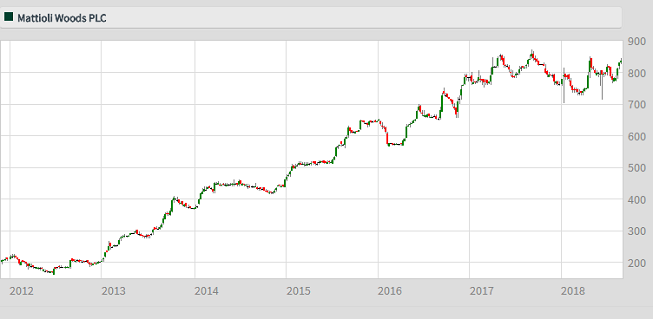Stockwatch: Are highly-rated financial stocks at an inflection point?
7th September 2018 10:30
by Edmond Jackson from interactive investor
This AIM share has been a very successful tip for companies analyst Edmond Jackson, but is it still or a buy or time to trouser fat profits?

In last week's macro piece, I examined Turkey and noted the view of credit market "experts" that its debt risks are contained. Spanish banks may need to collectively wipe off 10% of their net assets, otherwise there's scant risk of contagion from emerging markets' debt to developed country financial markets. Argentina, most likely, is c/o the IMF.
Yet traders have latched onto a more cautious view this week, spelled out in the FT's Thursday headline: "European equities follow Asia lower as currency crises fuel contagion fears". I have a sense of déjà vu going back to October 1987 when the Saturday before Black Monday, the Weekend FT was headlined: "Wall Street accepts the party is over" which was a trigger for me to sell what stocks I owned first thing - when you could actually get prices - before the market turned illiquid and Black Monday ensued.
That summer had seen various signs of excess and the late Sir James Goldsmith liquidated his holdings saying he'd "leave the top 10% to others", an adage unheard-of nowadays. Not to insist on a parallel, but I note that Goldman Sachs' bear market risk indicator is roughly at 75% versus 67% a year ago which coincided with its level before the 2000 and 2007 market crashes.
Goldman's strategists suggest potentially a sharp "cathartic" bear market, but reckon the more likely scenario is a long period of low - possibly negative - returns from stocks up to 2023. Obviously, various strategists have claimed the central banks’ monetary stimulus bubble is primed to burst, pretty much since 2010.
Yet now is a relevant time to consider which stocks in a portfolio are on rich valuations, thus capable of at least drifting back simply because market sentiment changes, than anything adverse at the companies involved. Financial services stocks in particular tend to be darlings of a mature bull market.
Very strong prelims to 31 May 2018
The AIM-listed shares of wealth and pensions adviser/manager Mattioli Woods are a timely example. Capitalised at £222 million with the price currently 855p, Woods has declared annual pre-tax profit up 27.3% to £9.8 million on revenue up 16.2% to £58.7 million (15% up organically) with adjusted earnings pe share (EPS) up 11.1% to 37p. Management shows its confidence by raising the total dividend 21% to 17p.
Cash conversion is impressive, too: net cash flow from operations up 82.4% to £18.2 million hence net balance sheet cash of £20.2 million – a strong position to further consolidate the Independent Financial Adviser industry, making acquisitions.
George Osborne's liberation of pensions was only three years ago, thus likely to sustain demand for advice also wealth management. Despite final salary pension transfers possibly peaking, a trend remains of people trying to do their own thing outside organised pension schemes.
It's significantly why Mattioli Woods' gross discretionary assets under management have soared 29.3% over 12 months to £2.34 billion, helping boost its recurring revenues to 81.7% of group total, albeit which are "linked to the value of funds under management and advice".
Income from portfolio management charges has jumped 32.7% to £14.2 million with the value of clients' assets up 17.5% to £1.34 billion. Note how such aspects of profit are operationally geared i.e. what if asset growth was to stymie or indeed fall?
Agile firms would likely manage through the challenges, maybe incur restructuring charges, although earnings and their rating would likely fall from price/earnings (PE) multiples in a 20-30 times range. That's not a prediction, rather a scenario it's wise to be steeled for.
Current valuations don't allow for any bad news
So, consider now which stocks - in any sector - are exposed to an autumnal shift in market sentiment, whose valuations allow for no bad news (or wariness of it).
In recent years I've drawn attention to Mattioli Woods variously from 455p in July 2014 when its forward PE multiple was about 17 times, though I was quite cautious even back then - suggesting you wait for a possible break in the market.
This took the stock below 400p, then over 2015 it rose to 650p and in September 2016 I noted its underlying commercial momentum likely justified the 21 times PE, i.e. "add" at 685p. "With the Bank of England declaring more monetary stimulus I wouldn’t expect the rating to come down much." This has now changed as central banks tighten policy gingerly.
The relatively affluent "baby-boomers" from the 1960s and 1970s still support financial flows into investment assets, though this has benefited from nearly a decade of overall rising prices. It helps explain why this stock's annual average historic PE multiple reached a 30's range (see table) in 2016-17, and, if the company broker's forecast for the current year is fair, then at 855p the forward PE multiple is 21.5 times. That's hardly extended if the party continues in financial assets/advice, notwithstanding a jolt anytime this autumn.

Source: interactive investor Past performance is not a guide to future performance
Updating the table, I noticed however the 2018 forecast appeared to have been downgraded at some point, and unless upgrades follow and the 2020 outlook looks enticing, then Mattioli Woods' projected rate of earnings growth is slowing into single figures.
Dividing the PE multiple by the underlying growth rate bumps the "PEG" ratio over 2.0 times when value in growth stocks normally demands sub 1.5 and preferably 1.0 (criteria for the late Jim Slater).
PEGs have a narrow focus by way of earnings dynamics and time horizon, so mind they can vary dramatically, but it underlines how Mattioli Woods really needs upgrades to sustain its valuation. The stock did peak at 861p about a year ago, then drifted to 730p by last spring, as if holders know not to push their luck.
Otherwise props are lacking. Assuming the dividend forecast is borne out, the stock would need to halve to about 425p to yield 4.7% (a more meaningful return), yet market value would still be twice net tangible assets. Not surprisingly, an acquisitive "people business" like this has intangibles constituting 55% of net assets, though in a bear market perception can easily shift to bare bones.
| Mattioli Woods - financial summary | Estimates | ||||||
|---|---|---|---|---|---|---|---|
| year ended 31 May | 2013 | 2014 | 2015 | 2016 | 2017 | 2018 | 2019 |
| Turnover (£ million) | 23.4 | 29.3 | 34.6 | 43.0 | 50.5 | 58.7 | |
| IFRS3 pre-tax profit (£m) | 4.6 | 5.1 | 5.3 | 6.3 | 7.7 | 9.8 | |
| Normalised pre-tax profit (£m) | 4.8 | 5.2 | 5.5 | 6.6 | 8.1 | 9.6 | 9.8 |
| Operating margin (%) | 20.5 | 17.5 | 15.8 | 15.0 | 15.5 | 16.4 | |
| IFRS3 earnings/share (p) | 18.8 | 21.7 | 19.4 | 21.1 | 24.4 | 31.1 | |
| Normalised earnings/share (p) | 19.9 | 20.8 | 20.5 | 20.8 | 33.3 | 37.0 | 39.8 |
| Earnings per share growth (%) | 9.0 | 4.9 | -1.7 | 0.7 | 61.0 | 11.1 | 7.6 |
| Price/earnings multiple (x) | 23.1 | 21.5 | |||||
| Price/earnings-to-growth (x) | 2.1 | 2.8 | |||||
| Annual average historic P/E (x) | 14.9 | 20.6 | 26.1 | 31.5 | 34.3 | 25.9 | |
| Cash flow/share (p) | 27.7 | 19.3 | 30.2 | 40.7 | 34.3 | ||
| Capex/share (p) | 3.6 | 4.6 | 4.4 | 6.5 | 34.0 | ||
| Dividend per share (p) | 6.0 | 7.8 | 9.3 | 11.0 | 14.1 | 17.0 | 20.2 |
| Yield (%) | 2.0 | 2.4 | |||||
| Covered by earnings (x) | 3.4 | 2.7 | 2.3 | 1.9 | 2.0 | 2.2 | 2.0 |
| Net tangible assets per share (p) | 26.8 | 32.7 | 52.1 | 88.0 | 109 | 138 |
Source: Company REFS Past performance is not a guide to future performance
'Hold' versus 'Take Profits' dilemmas
Mattioli Woods' fundamentals imply 'strong hold': like various successful firms currently there's nothing in its figures or narrative to warrant 'sell’. Market valuations tend to reflect this – and probably a bit more, in anticipation – which is acceptable while narratives remain bullish and zilch returns from cash mean people remain (near) fully invested.
But once "capital protection" creeps into investors' mindsets it’s possible to see stocks retreat from racier values even before companies indicate any adverse change.
I've been content to advocate this stock on the basis it can grow into demanding valuations, yet it's becoming necessary to steel for different macro scenarios and unwise to ignore dark clouds on the global horizon.
If you are also exposed to AFH Financial Group and Lighthouse Group to capitalise on growth from the UK pensions industry, you might want to review your extent of exposure if their overall portfolio weighting is high.
It's not an outright 'sell' stance, more a case of not pushing your luck where growth valuations may be at an inflection point if the central bank-driven bull market is now exposed to cracks, particularly in financial services where returns significantly relate to asset values. This is especially relevant if your holding is sizeable: Take profits.
Edmond Jackson is a freelance contributor and not a direct employee of interactive investor.
These articles are provided for information purposes only. Occasionally, an opinion about whether to buy or sell a specific investment may be provided by third parties. The content is not intended to be a personal recommendation to buy or sell any financial instrument or product, or to adopt any investment strategy as it is not provided based on an assessment of your investing knowledge and experience, your financial situation or your investment objectives. The value of your investments, and the income derived from them, may go down as well as up. You may not get back all the money that you invest. The investments referred to in this article may not be suitable for all investors, and if in doubt, an investor should seek advice from a qualified investment adviser.
Full performance can be found on the company or index summary page on the interactive investor website. Simply click on the company's or index name highlighted in the article.